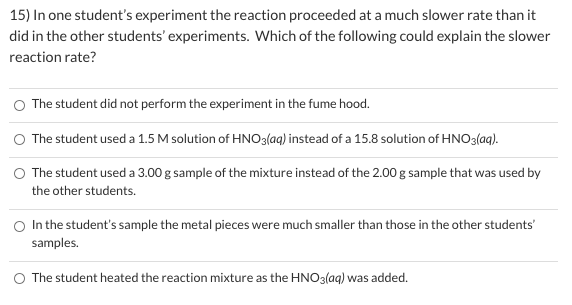15) In one student's experiment the reaction proceeded at a much slower rate than it did in the other students' experiments. Which of the following could explain the slower reaction rate? O The student did not perform the experiment in the fume hood. O The student used a 1.5 M solution of HNO3(aq) instead of a 15.8 solution of HNO3(aq). O The student used a 3.00 g sample of the mixture instead of the 2.00 g sample that was used by the other students. In the student's sample the metal pieces were much smaller than those in the other students' samples. O The student heated the reaction mixture as the HNO3(aq) was added.
15) In one student's experiment the reaction proceeded at a much slower rate than it did in the other students' experiments. Which of the following could explain the slower reaction rate? O The student did not perform the experiment in the fume hood. O The student used a 1.5 M solution of HNO3(aq) instead of a 15.8 solution of HNO3(aq). O The student used a 3.00 g sample of the mixture instead of the 2.00 g sample that was used by the other students. In the student's sample the metal pieces were much smaller than those in the other students' samples. O The student heated the reaction mixture as the HNO3(aq) was added.
Chemistry
10th Edition
ISBN:9781305957404
Author:Steven S. Zumdahl, Susan A. Zumdahl, Donald J. DeCoste
Publisher:Steven S. Zumdahl, Susan A. Zumdahl, Donald J. DeCoste
Chapter1: Chemical Foundations
Section: Chapter Questions
Problem 1RQ: Define and explain the differences between the following terms. a. law and theory b. theory and...
Related questions
Question

Transcribed Image Text:15) In one student's experiment the reaction proceeded at a much slower rate than it
did in the other students' experiments. Which of the following could explain the slower
reaction rate?
O The student did not perform the experiment in the fume hood.
O The student used a 1.5 M solution of HNO3(aq) instead of a 15.8 solution of HNO3(aq).
O The student used a 3.00 g sample of the mixture instead of the 2.00 g sample that was used by
the other students.
In the student's sample the metal pieces were much smaller than those in the other students'
samples.
O The student heated the reaction mixture as the HNO3(aq) was added.

Expert Solution
This question has been solved!
Explore an expertly crafted, step-by-step solution for a thorough understanding of key concepts.
This is a popular solution!
Trending now
This is a popular solution!
Step by step
Solved in 2 steps

Knowledge Booster
Learn more about
Need a deep-dive on the concept behind this application? Look no further. Learn more about this topic, chemistry and related others by exploring similar questions and additional content below.Recommended textbooks for you

Chemistry
Chemistry
ISBN:
9781305957404
Author:
Steven S. Zumdahl, Susan A. Zumdahl, Donald J. DeCoste
Publisher:
Cengage Learning

Chemistry
Chemistry
ISBN:
9781259911156
Author:
Raymond Chang Dr., Jason Overby Professor
Publisher:
McGraw-Hill Education

Principles of Instrumental Analysis
Chemistry
ISBN:
9781305577213
Author:
Douglas A. Skoog, F. James Holler, Stanley R. Crouch
Publisher:
Cengage Learning

Chemistry
Chemistry
ISBN:
9781305957404
Author:
Steven S. Zumdahl, Susan A. Zumdahl, Donald J. DeCoste
Publisher:
Cengage Learning

Chemistry
Chemistry
ISBN:
9781259911156
Author:
Raymond Chang Dr., Jason Overby Professor
Publisher:
McGraw-Hill Education

Principles of Instrumental Analysis
Chemistry
ISBN:
9781305577213
Author:
Douglas A. Skoog, F. James Holler, Stanley R. Crouch
Publisher:
Cengage Learning

Organic Chemistry
Chemistry
ISBN:
9780078021558
Author:
Janice Gorzynski Smith Dr.
Publisher:
McGraw-Hill Education

Chemistry: Principles and Reactions
Chemistry
ISBN:
9781305079373
Author:
William L. Masterton, Cecile N. Hurley
Publisher:
Cengage Learning

Elementary Principles of Chemical Processes, Bind…
Chemistry
ISBN:
9781118431221
Author:
Richard M. Felder, Ronald W. Rousseau, Lisa G. Bullard
Publisher:
WILEY